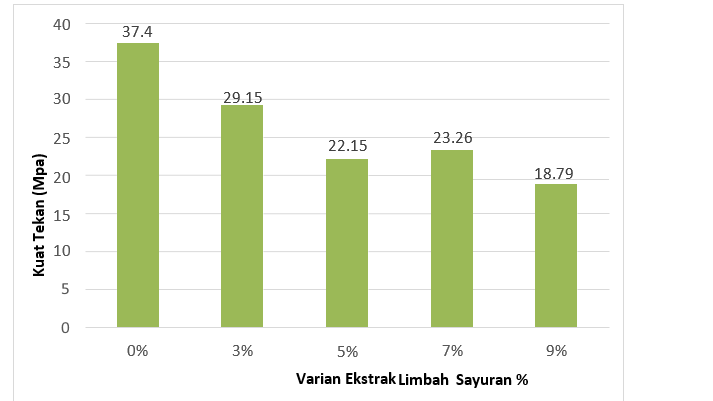Pemanfaatan Limbah Sayur Sebagai Agen Dalam Pembuatan Beton Pulih Mandiri
Utilization of Vegetable Waste as an Agent in Self Healing Concrete
DOI:
https://doi.org/10.25299/saintis.2023.vol23(02).11477Keywords:
Beton, Pulih, MandiriAbstract
[ID] Beton merupakan bahan kontruksi yang terdiri dari campuran material seperti semen, agregat dan air serta bahan tambahan lainnya (additive). Saat ini penggunaan beton semakain meningkat karena beton merupakan bahan kontruksi yang memiliki beberapa kelebihan, seperti mudah dalam proses pengerjaannya dan harga material penyusunnya relatif murah serta mudah didapatkan. Tujuan penelitian ini untuk mengetahui perubahan pada fisik beton menggunakan campuran ekstrak limbah sayuran dan menganalisa pengaruh faktor nilai slump 10-30 terhadap nilai kuat tekan beton pada mutu beton self healing dengan metode yang digunakan untuk menghitung campuran beton (Mix Design) berdasarkan SNI 03-2834-2000. Hasil nilai slump pada penelitian self healing concrete dengan nilai slump 10-30 mm pada beton varian ekstrak limbah sayuran 0% dan 3% memenuhi standar yaitu 20mm dan 30mm. Sedangkan pada varian 5%, 7% dan 9% tidak memenuhi standar yaitu 140mm, 220mm dan 200mm. Hasil kuat tekan beton pada perendaman umur 28 hari pada pengadukan pertama dengan varian 0%, 3%, 5%, 7% dan 9% mengalami penurunan berturut-turut dari 37,40 Mpa, 28,76 Mpa, 25,01 Mpa, 20,30 Mpa, dan 20,14 Mpa. Untuk pengadukan kedua pada varian 0%, 3% dan 5% mengalami penurunan dari varian 0% yaitu 37,40 Mpa, 29,15 Mpa dan 22,15 Mpa, sedangkan varian 7% mengalami kenaikan yaitu 23,26 Mpa dan varian 9% mengalami penurunan yaitu 18,79 Mpa. Penglihatan secara visual pada beton yang diretakkan pada varian 3% dan 5% mengalami pemulihan di hari ke 14 dan hari ke 21, tetapi tidak dapat memulihkan retakan sepenuhnya pada beton. Sedangkan pada varian 7% dan 9% dapat memulihkan di hari ke 14 dan hari ke 10 hampir pulih sepenuhnya.
Kata Kunci: Beton, Self Healing Concrete, Ekstrak Limbah Sayuran, Kuat Tekan, Nilai Slump.
[EN] Concrete is a construction material consisting of a mixture of materials such as cement, aggregate and water as well as other additives. Currently the use of concrete is increasing because concrete is a construction material that has several advantages, such as being easy to process and the price of the material being made is relatively cheap and easy to obtain. The purpose of this study is to determine changes in the physical concrete and analyze the effect of the slump value of 10-30 on the value of the compressive strength of concrete on the quality of self-healing concrete with the method used to calculate the concrete mix (Mix Design) based on SNI 03-2834- 2000. The results of the slump value in the self-healing concrete study with a slump value of 10-30 mm on the 0% and 3% vegetable waste extract variant concrete met the standards, namely 20mm and 30mm. While the 5%, 7% and 9% variants do not meet the standards, namely 140mm, 220mm and 200mm. The results of the compressive strength of concrete at 28 days of immersion in the first mixing with variants of 0%, 3%, 5%, 7% and 9% decreased from 37,40 Mpa, 28,76 Mpa, 25,01 Mpa, 20,30 Mpa and 20,14 Mpa. For the second mixing the 0%, 3% and 5% variants experienced a decrease from the 0% variant, namely 37,40 Mpa, 29,15 Mpa and 22,15 Mpa, while the 7% variant experienced an increase of 23,26 Mpa and variant 9% experienced a decrease of 18,79 Mpa. Visually the cracked concrete in the 3% and 5% variants recoveredon day 14 and day 21, but could not fully restore the cracks in the concrete. Whilethe 7% and 9% variants can recover on day 14 and day 10 almost fully recovered.
Keywords: Concrete, Self Healing Concrete, Vegetable Waste Extract, Compressive Strength, slump value.
Downloads
References
(1) Afifah, Siti. 2017. Pengaruh Kuat Lentur Balok Self Healing Concrete Dengan Bacillus Subtilis Terhadap Umur Perawatan. Universitas Muhammadiyah. Yogyakarta.
(2) Agustin, M. (2014). Permasalahan Belajar dan Inovasi Pembelajaran. Bandung: Refika Aditma.
(3) Antoni, & Nugraha, P. 2007. Teknologi Beton. C. V Andi Offset.
(4) Asroni, A., 2010. Struktur Beton I (Balok dan Plat Beton Bertulang), Graha Ilmu, Yogyakarta.
(5) Dick, J., De Windt, W., De Graef, B., Saveyn, H., Van Der Meeren, P., De Belie, N., & Verstraete, W. 2006. Bio-deposition of a calcium carbonate layer on degraded limestone by Bacillus species. Biodegradation, 17(4), 357-367. https://doi.org/10.1007/s10532-005-9006-x
(6) Mulyadi, Asri. Diawarman dan Donny Ismail. 2018. Pengaruh Penambahan Limbah Plastik Terhadap Kuat Tekan Mutu Beton K-175. Jurnal Teknik Sipil UNPAL Vol 8, NO 2 November.
(7) Mulyono, T., 2003. Teknologi Beton. Yogyakarta : penerbit Andi.
(8) Mulyono, T., 2004. Teknologi Beton, Edisi Kedua, Andi Yogyakarta.
(9) Mulyono. Yoga Surya Wijaya. 2020. Pengaruh Limbah Gypsum Pada Kuat Tekan Beton. Universitas Semarang.
(10) Ningsih, Wahyu. 2021. Pemanfaatan Limbah Kulit Kerang Darah (Anadara Granosa) Sebagai Pengganti Sebagian Semen Pada Campuran Beton. (pp. 1-162). Universitas Islam Riau. Pekanbaru

Downloads
Published
Issue
Section
License
Copyright (c) 2023 Harmiyati

This work is licensed under a Creative Commons Attribution-ShareAlike 4.0 International License.

This work is licensed under a Creative Commons Attribution-ShareAlike 4.0 International License.
Copyright. This is an open access article which means that all content is freely available without charge to the user or his/her institution. Jurnal Saintis allows the author(s) to hold the copyright without restriction. The copyright in the text of individual articles (including research articles, opinion articles, and abstracts) is the property of their respective authors distributed under the terms of the Creative Commons Attribution-ShareAlike 4.0 International License which permits unrestricted use, distribution, and reproduction in any medium. Users are allowed to read, download, copy, distribute, search, or link to full-text articles in this journal without asking by giving appropriate credit, provide a link to the license, and indicate if changes were made.





